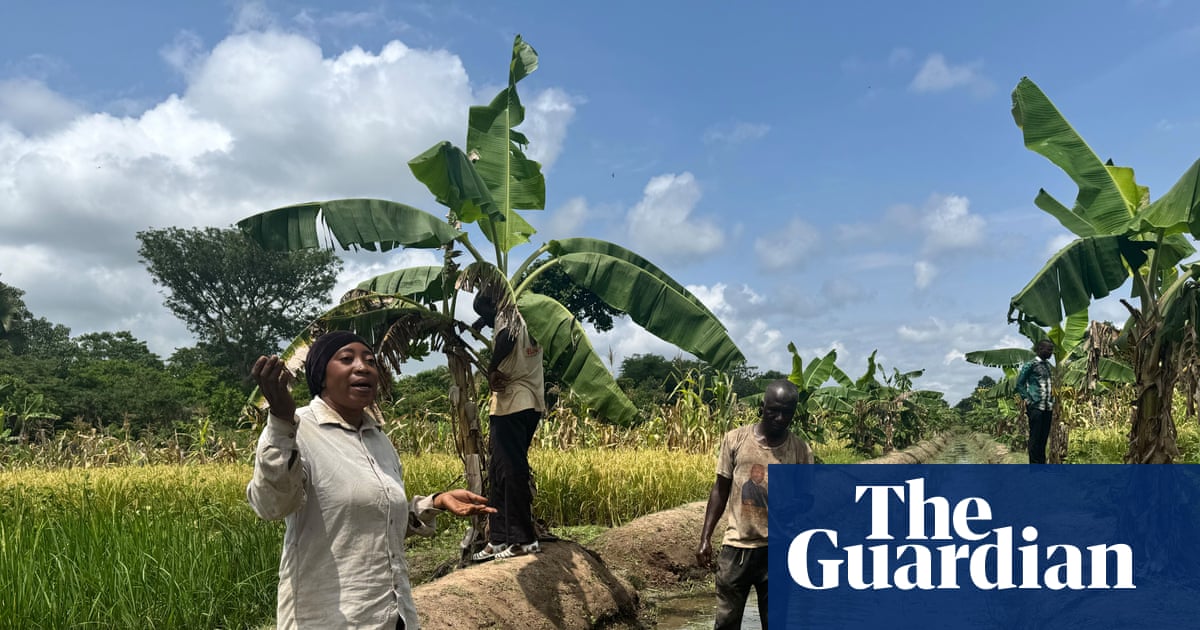Africa Rice initiative aims to give farmers more control over their land in order to reduce flooding and increase yields
Salmata Ouattara remembers 2023 as the turning point for her rice farm.
June is usually the peak of the rainy season in Ivory Coast, but in the preceding years she and other farmers in M’Be on the outskirts of Bouaké, the country’s second biggest city, would wait weeks for rainfall. Then in September, they would watch helplessly as their farmlands were flooded. Some abandoned their farms, frustrated by fluctuating crop yields.
For Ouattara, that was not an option. As her family’s breadwinner, proceeds from the farm catered to the needs of her three children as well as requests from other relatives. Then another farmer mentioned a concept called Smart Valleys that had helped solve similar issues and double his income.
“Before, I made 2 tonnes a year [and] earned at least 400,000CFA [west African francs, equivalent to £528.60],” said Ouattara, who has since added maize, tomatoes and cucumbers to her portfolio. “But as soon as we put Smart Valleys into practice, I made 4.5 tonnes, which makes me 900,000CFA (£1,189.34).”
Smart Valleys is a low-cost initiative by the nonprofit organisation Africa Rice that aims to help farmers get better control over the water on their land, for example by using channels, in order to reduce flooding and increase yields. It also helps farmers diversify crop production.
The programme – backed primarily by Japan’s agriculture ministry – focuses on inland valleys, low-lying areas between hills with fertile soils that are ideal for agriculture but rarely cultivated due to poor water control. Its head, Elliott Dossou-Yovo, said the valleys cover 190m hectares in sub-Saharan Africa, of which only 10% is cultivated.
“In the past, farmers were trying to produce rice only once a year and failing,” said Dossou-Yovo. With his team’s support, fields that used to be abandoned during the dry season are cultivated with alternative crops, thereby diversifying farmers’ portfolios and increasing their incomes.
Africa Rice, established in 1971, set a goal to double rice production within a decade in 2009, when it changed its name from West Africa Rice Development Association. Since achieving that target, it has ambitiously turned to self-sufficiency for member states by 2030.
The core of its work happens a few miles away from Ouattara’s farm at an 800-hectare research campus, where there are facilities including testing sites, a seed science lab and gene bank with 22,000 rice varieties used by scientists to develop improved strains.
Funders include the Gates Foundation, the World Bank, and donor partners including Islamic Development Bank and African Development Bank, though member states also make contributions.
The need for Africa Rice arose because in the 1960s and 70s, rice consumption and population growth surpassed food production rate in west Africa, Baboucarr Manneh, its Gambian-born director general, said. Today, rice that was previously reserved for feasting occasions, is arguably the continent’s most popular staple.
“Rice is very popular because it is easy to cook,” he said. “It used to seem like a luxury food to many consumers, compared with maize and millet. If you go to Sierra Leone, they used to consume a lot of roots and tubers etc, but people now associate those foods with poverty so they prefer rice.”
“Our goal is to make rice not just an energy-dense food, but a nutrient-dense food … and at the same time, reduce the impact of rice causing peaks in glucose levels when people consume it,” he said. One way to do this, the team thinks, is to promote the consumption of parboiled rice – which some studies have shown has a lower impact on blood sugar levels – in countries such as Ivory Coast, where it is historically unpopular, to mirror countries like Nigeria where it is prevalent.
Ndindeng’s teams also make pop rice that can be ground to instant flour for children to eat with milk and chocolate as well as rice crackers integrated with local items including ginger, hibiscus, soy and tamarind which are high in zinc and iron, to tackle deficiencies in those micronutrients.
Many barriers are holding back member countries from reaching self-sufficiency. For years, cheap imports have flooded African markets from Asia, where producers benefit from heavy subsidies.
Africa imports about 40% of rice it consumes – about 15 to 16 million tonnes every year. More than half of the imports come from India alone.
In July 2023, India banned rice exports, citing the need to consume more locally. “That created a panic in Africa,” said Manneh. “African ministers had to go to India to negotiate.”
Only a fifth of rice fields in Africa use irrigation, with the rest relying on unpredictable rainfall, so member states are being guided on building climate-resilient systems.
Tanzania is self-sufficient and exporting within east Africa. In west Africa, Nigeria, is close to doing so.
Manneh is hoping for more success stories on a national level, but also on an individual level with farmers such as Ouattara, who are still stunned by what science is doing for their lives.
“They welcomed me … They guided me and I thank them,” she said.
Source: www.theguardian.com
